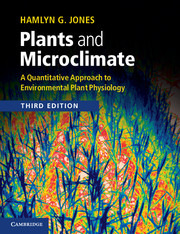Book contents
- Frontmatter
- Contents
- Preface
- Acknowledgements
- Symbols
- Main abbreviations and acronyms
- 1 A quantitative approach to plant–environment interactions
- 2 Radiation
- 3 Heat, mass and momentum transfer
- 4 Plant water relations
- 5 Energy balance and evaporation
- 6 Stomata
- 7 Photosynthesis and respiration
- 8 Light and plant development
- 9 Temperature
- 10 Drought and other abiotic stresses
- 11 Other environmental factors: wind, altitude, climate change and atmospheric pollutants
- 12 Physiology and crop yield improvement
- Appendices
- References
- Index
8 - Light and plant development
Published online by Cambridge University Press: 05 June 2014
- Frontmatter
- Contents
- Preface
- Acknowledgements
- Symbols
- Main abbreviations and acronyms
- 1 A quantitative approach to plant–environment interactions
- 2 Radiation
- 3 Heat, mass and momentum transfer
- 4 Plant water relations
- 5 Energy balance and evaporation
- 6 Stomata
- 7 Photosynthesis and respiration
- 8 Light and plant development
- 9 Temperature
- 10 Drought and other abiotic stresses
- 11 Other environmental factors: wind, altitude, climate change and atmospheric pollutants
- 12 Physiology and crop yield improvement
- Appendices
- References
- Index
Summary
Introduction
The ability of plants to modify their patterns of development appropriately in response to changes in the aerial environment is a major factor in their adaptation to specific habitats. These morphogenetic responses are usually taken to include quantitative changes in growth (both cell division and cell expansion), as well as differentiation of cells and organs and even changes in metabolic pathways. Important examples include: the tendency for stem elongation to be greater in certain classes of shade plants, thus enabling them to outgrow competitors; the development of characteristic ‘sun’ and ‘shade’ leaves with appropriate biochemical and physiological characteristics (see Chapter 7); the induction of flowering or other reproductive growth at an appropriate season and the induction of dormancy. For many of these developmental responses some feature of the light environment provides the main external signal, though other important signals can include temperature (see Chapter 9) and water availability.
In addition to affecting development through effects on photosynthesis (for example, rapid growth depends in part on high rates of photosynthesis) and on cellular damage (e.g. DNA damage caused by high irradiance UV-B), light can influence growth and development in a number of ways. These photomorphogenic responses, which are summarised in Table 8.1 include:
Phototropism – those directional alterations in growth that occur in response to directional light stimuli, as shown by the growth of shoots towards the light.
Photonasty – reversible light movements and related phenomena that occur in response to directional and non-directional light stimuli.
[…]
- Type
- Chapter
- Information
- Plants and MicroclimateA Quantitative Approach to Environmental Plant Physiology, pp. 207 - 223Publisher: Cambridge University PressPrint publication year: 2013



